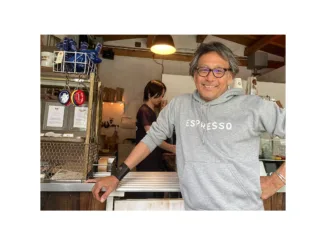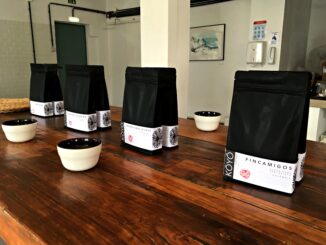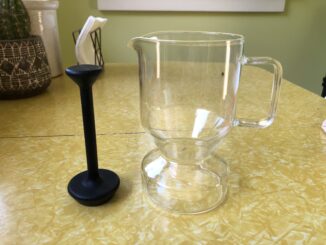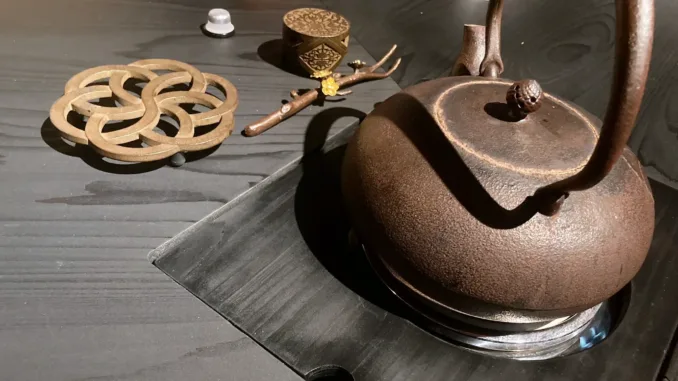
Tokyo offers some unique and exciting coffee experiences, including the exclusive coffee omakase at Cokuun, which I had the pleasure of attending.
BY TANYA NANETTI
SENIOR ONLINE CORRESPONDENT
Photos by Tanya Nanetti
When making note of all the cafés I wanted to visit in Tokyo, one place jumped to the top of my bucket list: Cokuun and its renowned coffee omakase. Cokuun is accessible only by reservation, with a secret location revealed only once the reservation is confirmed, and a maximum capacity of four people per experience. It was a mystery I wanted to explore.
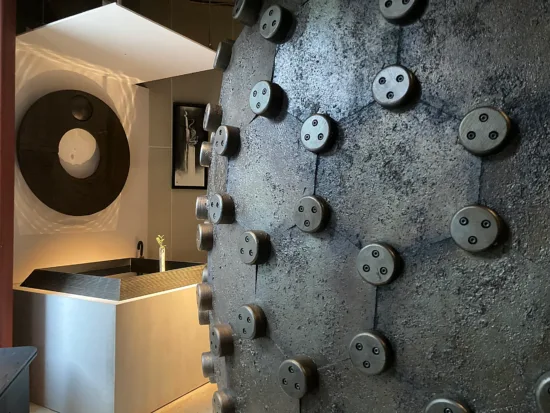
At Cokuun
Once I reached Cokuun’s secret location a bit early, I was greeted by Miki Suzuki, three-time Japan Barista Champion and our barista and host for the day. The small, dimly lit space was a quiet room; the only sound was a single drop that kept falling into a square basin, reflecting a beautiful effect in the nearby wall.
I had not yet entered the bar proper, and already I felt as if I had entered a zen garden.
Once the other guests had arrived, it was time for the omakase experience to begin. Shoes removed, we walked a short path to the entrance of the coffee room, a black cocoon that Miki explained was built to resemble a classic Japanese teahouse in every aspect, starting with the small entrance door traditionally built for participants to bow and show respect upon entering the space.
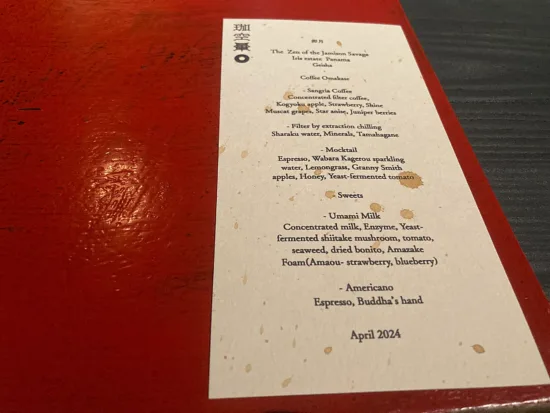
What Is Omakase?
After we took our seats and briefly introduced ourselves, the omakase began with a brief explanation from Miki about what to expect.
“We call our style coffee omakase,“ Miki said. “Omakase in Japanese means ’leave it up to you,’ and typically refers to a chef’s selection of dishes using the freshest ingredients available. In the field of coffee, Omakase embodies a ’fine dining experience of serving specialty coffee.’ In this case, the barista takes on the role of chef, selecting the best coffees to create an experience tailored to the guest. We want to enhance the specialty-coffee experience and create a platform where experienced baristas can showcase their expertise like celebrity chefs.“
Coffee and Water Sources
Based on the menu, I could already expect an exciting experience, consisting of five different coffee courses (plus a sweet interlude). All would be prepared using the same exclusive house-roasted coffee produced by Jamison Savage. Miki explained that the coffee comes from the Iris Estate (1,600-1,900 masl), one of the highest-elevation farms in Panama. There, coffee grows very slowly because of climate conditions. The farm produces small, highly selective micro-lots.
Before starting the omakase, Miki made one last point about the other most important ingredient in any brewed coffee: water. At Cokuun, the water chosen for brewing—the best they found after months of testing—has a ppm of about 100. It comes from the Fukushima area and is traditionally used for sake production (and is indeed sold in a beautiful traditional sake bottle). We tasted a full glass to feel its purity and were ready to begin.
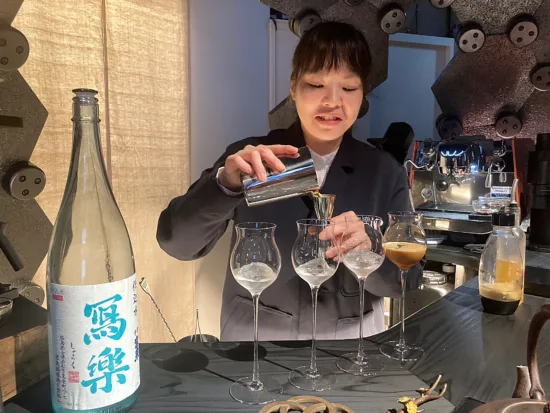
Courses 1 & 2: Sangria and Pourover
The first course was an alcohol-free coffee sangria served warm to combat the unexpected cold. Homemade sangria syrup with fruit and spices mixed with concentrated coffee for a comforting drink. It reminded me of the fruity punches of my teenage years.
Then it was time for Miki to start brewing the second course: the Iris Estate extracted as a pourover. The twist: The brewing technique was enhanced by the use of refrigerated paragon technology, which helps boost a coffee’s aroma, keeping some of its volatile compounds from evaporating too quickly. As the water simmered slowly, Miki took the opportunity to spend a few minutes introducing us to the importance of the right object in Japanese tea culture (and in Cokuun’s coffee experience), where every single cup, teapot, and object must be made in the right shape and with the right material.
Following this ideal, at Cokuun the large teapot used to boil the water is made of Tamahagane, a durable steel once used for samurai armor. Its thick body helps to sweeten and round out the flavor of the boiled water, which will then pass through a classic coffee kettle to reach—while adding a little cold water—the perfect brewing temperature.
The resulting coffee was a tropical, sweet fruit bomb served in original coffee cups made from Arita porcelain. The shape was inspired by the whiskey tasting glass, perfect for bringing out a coffee’s unique aromas and flavors.
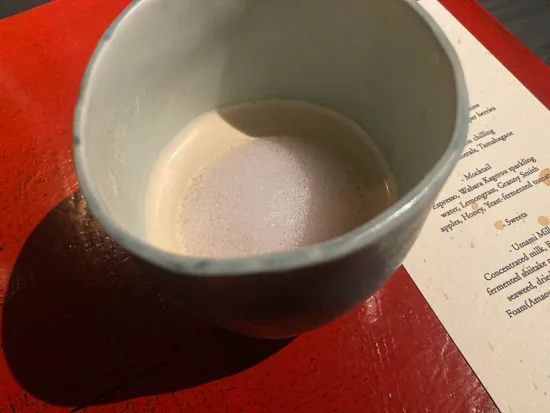
Courses 3 & 4: Mocktail and Umami Milk
The next course was the coffee mocktail. The idea was to mix the chosen coffee with unique seasonal Japanese ingredients to create an original drink in which each addition helps highlight an intrinsic characteristic of that specific coffee.
Lemongrass infused into the espresso increased acidity; fermented tomato juice added umami flavor; and homemade honey-apple syrup added sweetness; these were just some of the ingredients blended into the delicious mocktail. We enjoyed it along with a homemade chocolate and kumquat ice cream, served with strawberries and pink peaches.
At this point, Miki started making the drink that most left me speechless. “Umami milk“ is made of four different homemade fermented yeast extracts (tomato, seaweed, shiitake, dried bonito flakes) with enzyme, espresso, and the star of the drink: the milk.
Sourced from a single variety of cows from Kikuchi Farm in Hokkaido, and pasteurized but not homogenized, the milk was already sweet and creamy on its own. Steamed with all the other ingredients and served with a foam of blueberries and strawberries, it yielded something incredible, almost like a hot and juicy smoothie, extra sweet and fruity.
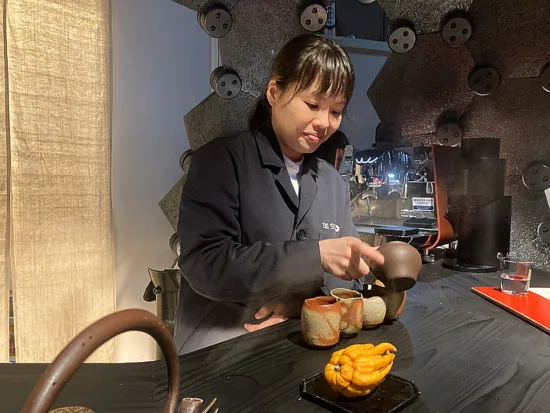
The Final Course: A Twist on an Americano
To conclude the omakase with a slightly more traditional and caffeinated course, Miki served us the last course: a classic Americano in which the espresso was extracted in a small traditional teapot. It was diluted with hot water and left to steep for a few seconds with a small finger taken from the Buddha’s hand citrus, grown in Hiroshima in southern Japan. This simple addition brought out the coffee’s natural mango flavor and acidity, creating the perfect drink to end the omakase experience.
Cokuun’s coffee omakase was one of the most memorable coffee experiences I have ever participated in, perfect because of the very high quality of the ingredients used and all the amazing techniques we got to discover and experience through the five different courses. Moreover, what gave Cokuun its uniqueness was the exclusivity of the experience, a zen moment more like a dinner at a starred restaurant than just an afternoon spent drinking coffee. It was the feeling of being part of something special, and unrepeatable.
ABOUT THE AUTHOR
Tanya Nanetti (she/her) is a specialty-coffee barista, a traveler, and a dreamer. When she’s not behind the coffee machine (or visiting some hidden corner of the world), she’s busy writing for Coffee Insurrection, a website about specialty coffee that she’s creating along with her boyfriend.
Subscribe and More!
Out now: It’s the April + May 2024 issue of Barista Magazine! Read it for free with our digital edition. And for more than three years’ worth of issues, visit our digital edition archives here.
You can order a hard copy of the magazine through our online store here, or start a subscription for one year or two.



